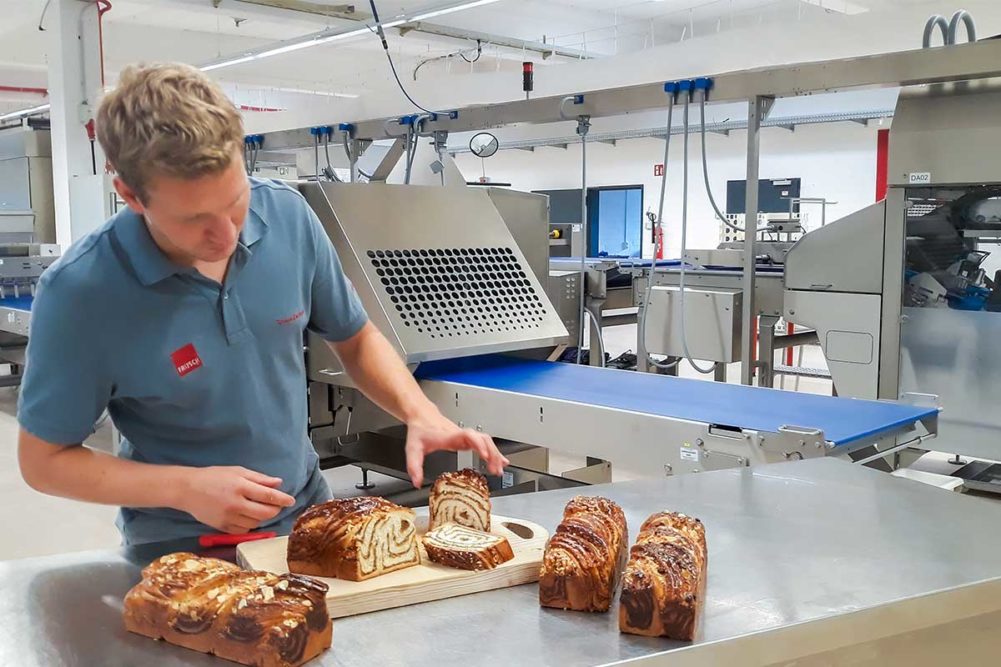Breakfast breads have been a consistent presence in the bread aisle. Whether they are packed with fruit, nuts and seeds or feature an aromatic cinnamon or another indulgent swirl in the center, these products aren’t going anywhere.
“It’s a mainstay in any bread aisle,” said David Moline, vice president of sales and marketing, Moline Machinery.
Those inclusions and swirls that make breakfast breads so enticing to consumers also come with their own production needs, whether its modular equipment and quick sanitation for flexibility or gentle dough processing for inclusion integrity. Designing a production line from the start to accommodate these needs can have bakers doling out these reliable products.
From a production perspective, marbled breads bring two different bread doughs together while swirl breads roll a base dough around a smear, dry toppings and even inclusions. Bakers can choose from several processing avenues to make these patterns appear in their pan breads.
“Marbling could be done by having two bread lines side by side delivering different colored doughs then combining these pieces at the moulder,” said Patricia Kennedy, president, WP Bakery Group USA. “The other way is to sheet the dough and put additives and swirl the dough.”
Bakers can also use coextrusion to bring two different doughs together. Dough is extruded into two strands that twist together as they exit the machine, creating the marbling effect. Rheon USA’s coextruder technology can not only twist two varieties of dough together, but it can also add separate fillings to each type of dough.
“In total, we can extrude and twist two colors of dough and two different fillings,” said John Giacoio, vice president, sales and marketing, Rheon USA. “Visually, this makes for a beautiful product, but when you bite into the bread, you also get the added surprise of a filling.”
Lamination can also provide a swirl in a bread. While traditional lamination layers butter and dough, butter can be replaced with chocolate or other fillings. Combined with a sidewinder, lamination creates a bread product with thinner swirls.
“With this method, we are also using a stress-free system, so the quality is unsurpassed, and the number of swirls can be several dozen, giving you a beautiful product,” Mr. Giacoio said.
Historically, however, swirled breads have been made using sheeting technology. Typically, automated swirl bread production includes a sheeting line to create the dough sheet of the base bread. Then depositors apply the filling or a strewer to add inclusions like fruit or nuts. A sidewinder then rolls up the dough. While a guillotine can cut the bread into its final loaf form, Mr. Giacoio said Rheon’s shutter system can provide a rounded end rather than the blunt cut.
“This type of sheeting system will give you a high-quality bread with beautiful cell structure and as many as six swirls,” he said.
With sheeting technology, bakers can fully automate the marbled effect.
“Combining different textures and colors of dough, layering them and rolling to create that swirl look is a process we automate to ensure consistent product quality, where before this was only done by the artisanal craft baker,” said Bruce Campbell, vice president, dough processing technologies, AMF Bakery Systems.
Automation also enables bakers to customize their processes to a wide range of products. AMF can bring together up to three different colors of dough in a marbled bread with its sheeting technology, said Hans Besems, executive product manager, AMF Tromp. Using fillings and layers of cinnamon, sugar and other ingredients, bakers can get creative.
“Our unique sheeting technology offers us the possibility to create separate layers and thus colors of bread,” he said. “By rolling them, the marble pattern will arise.”
Marbling multiple bread doughs together to create a pattern requires a lot of extra tooling, however. Bakeries need extra mixers and hoppers to feed the different doughs into the sheeting line to create top and bottom sheets.
“Not only will this require additional maintenance and upkeep, but you will have additional training required, and in some cases require additional labor to produce these breads,” said Randy Kelly, sales application specialist, Fritsch USA, a Multivac company.
Managing two different doughs to ensure product quality is consistent at the end of the line also takes some finesse in production planning, timing and streamlining product changeovers.
“You need to make sure you have both dough types ready to be fed onto the sheeting line at the same time,” Mr. Kelly explained. “It also helps to process the dough in a timely manner as you do not want the dough to gas or rise on the production line.”
This article is an excerpt from the July 2021 issue of Baking & Snack. To read the entire feature on Specialty Pan Bread, click here.





